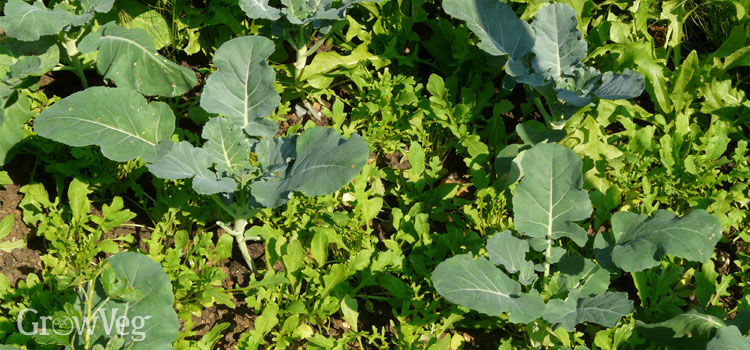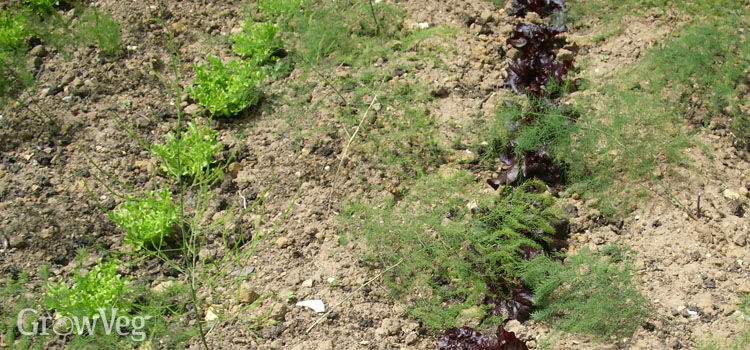As editor of a kitchen gardening magazine one of the questions I’m often asked by readers is, what can be done if you only have a small space in which to grow vegetables? The obvious answer is to grow crops that you most enjoy eating and that perhaps give you the biggest yield. Salad leaves, radishes, beets, zucchini and pole beans all fit into this category. The quickest growers can be repeatedly sown during the season, offering plenty of harvesting opportunities from even a bijou plot.
Another idea is to literally double up. How? By raising 2 vegetables in the same patch of ground at the same time. Sounds implausible I grant you, but this clever technique, known as ‘intercropping’, is where the smart gardener comes up trumps. With a little preparation and timing there’s no reason why you can’t have one vegetable starting out in life while another is reaching maturity – effectively overlapping the generations.
Double vision
The principle of inter-cropping is opportunism. In other words, while one vegetable is still filling out the crafty gardener sneaks in an additional crop that’s long gone before the main crop needs its space. Another take on intercropping is to sow or plant between vegetables whose spacing and/or leaves naturally allow plenty of light to reach the ground so that seedlings of a later-season crop can find their feet while the earlier crop is in its final weeks of growth.

When you stop to think about it intercropping like this has the potential to increase the breadth of what you can grow where the traditional mindset would have you conclude you can have one crop but not the other. The one proviso to all this is that your soil must be in good shape, having had plenty of organic matter added in preparation for the start of the season so that second comers can go in without losing momentum due to depleted nutrients.
Some examples
The strappy leaves of onions and garlic ensure there’s lots of scope for sunlight to reach ground level. Early to midsummer, a few weeks prior lifting these bulbs, presents a golden opportunity to sow the seeds of maincrop roots, including carrots and beets. Sown midway between your established rows of alliums they will happily germinate and develop into young plants so that by the time they need the room, your bulbs will have been hoiked out for eating, drying & storing.
The second half of summer is a good time to sow seeds or plant seedlings of fall salads such as mizuna, arugula or lamb’s lettuce. The first two are brassicas which have a horrid tendency to run to seed in a natural response to the days getting longer – by the latter half of summer the days are already beginning to draw in (a depressing thought, but let’s not dwell on it!) keeping these plants squat and producing plenty of luscious leaves rather than flowers. Try positioning these salads in-between the likes of bush beans, heads of regularly picked lettuce or beneath the frothy leaves of Florence fennel. Time your new intercrops so that they are sown or planted two to four weeks before the existing crop is removed to the compost heap.

An alternative to the above salads are young plants of module or pot-raised winter brassicas – the likes of kale, sprouting broccoli and cabbages. A tidy overlap makes really efficient use of space, ensuring a prompt start to picking.
Then, of course, there are the salads that are sown, grown and picked all within the time it takes for another vegetable just to establish. Summer squash, leeks and corn will all allow plenty of room between plants in their infant weeks – just long enough to enjoy a rapid round of radish, scallions, cut-and-come-again salad or baby turnips. Of course, it’s important to sow early on to avoid your salads being smothered or shaded by their lofty or rambunctious neighbours!
Sowing versus planting
For many quick growers and root crops sowing directly between an existing vegetable is a convenient, no-nonsense approach to starting off your intercrop. To intersow, simply remove any weeds then carefully fluff up the soil between the existing plants with a hand fork taking great pains not to unsettle its roots. Mark out your seed drill and sow accordingly. Whichever of the two crops is first to finish should be delicately twisted out of the soil in such a way that leaves the remaining crop undisturbed.

Interplanting – when module tray or pot-raised seedlings are planted out (rather than sown) between an existing crop – has its advantages. It does away with any need for thinning seedlings, which is trickier when delving through the foliage of another ‘in the way’ crop to get at them. Interplanting also extends the period of overlap, enabling seedlings to get well underway before they are committed to the ground. This is also a great way of getting around the problem of weeding, as the young plants will be big enough to distinguish from emerging weed seedlings, enabling worry-free hand weeding or hoeing.
Intercropping is the vegetable grower’s secret weapon. Sow and plant tactically and you will boost the total take from your plot with ease. I’m sure I’ve missed some classic intercropping combinations above, so please feel free to share your own tried-and-tested double acts below.
